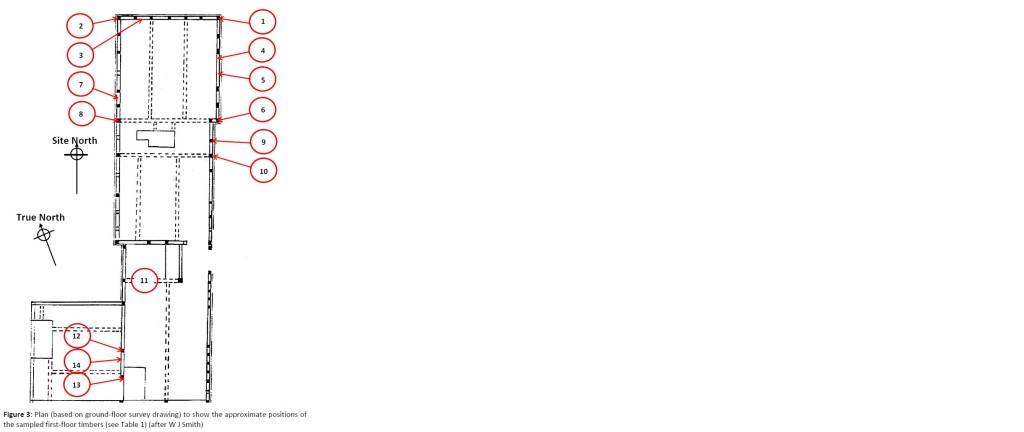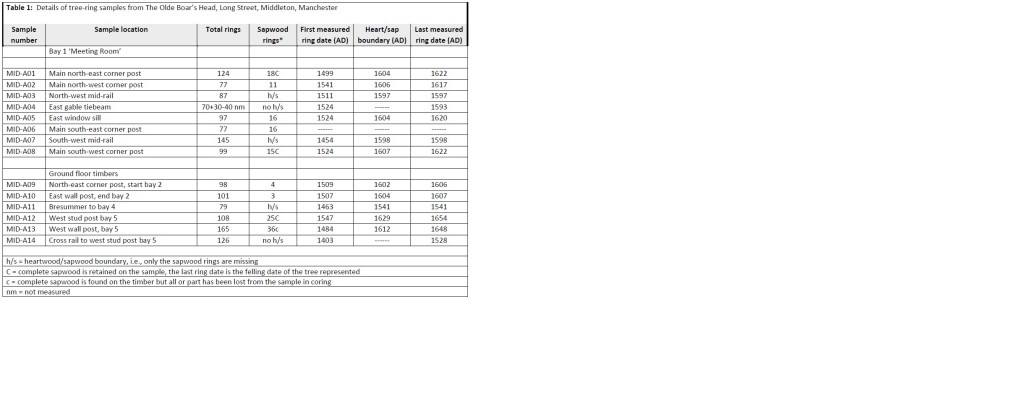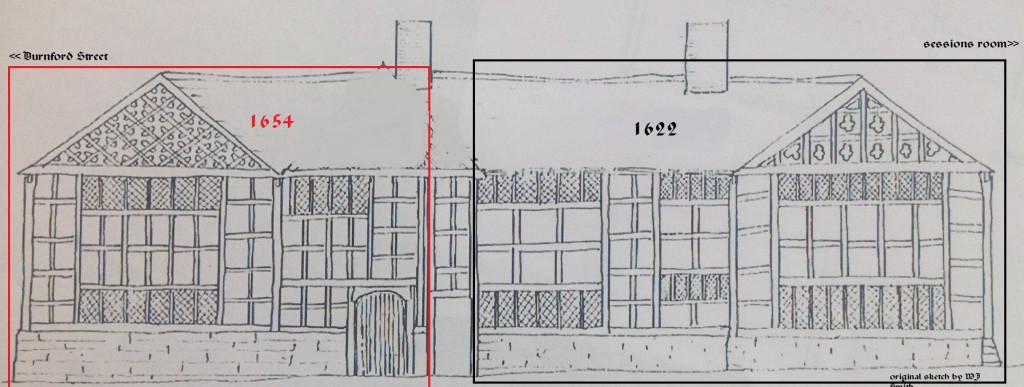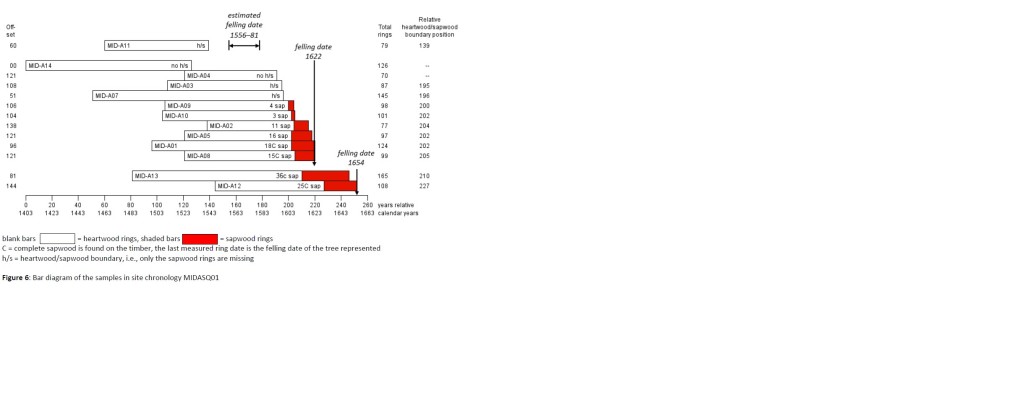In November 2015, MAS commissioned Tree-ring dating of its Middleton HQ, The Old Boar’s Head. This was funded by the Middleton Township Heritage Lottery fund and carried out by the Nottingham tree-ring dating laboratories. Despite being part of Middleton’s Golden Cluster of historic buildings, the timber framed building had never been dated.
The sampling work was assisted by MAS members and in January 2016 Robert Howard from NTRDL gave a sell out talk on Dendrochronology to members and guests. The dating gave two distinct building phases of 1622 and 1654 suggesting two houses which were joined together at an unknown date. The sessions room at the northern end of the current pub is of brick construction probably built over a cart entrance in the early 19th Century.
Download the Boar’s Head Tree-ring dating report
Extracts from the report
Introduction
The Olde Boar’s Head stands to the west side of Long Street, in Middleton (the A664 Middleton to Rochdale road), at its junction with Durnford Street (SD 87052 06266, Figs 1a/b). Having undergone some slight alteration over the years, the exact original form and layout is not completely clear, and the original function of the building is not known. However, given the form of the building and the level of decoration to the framing, it is perhaps more likely to have been a domestic site rather than an agricultural one.
The Olde Boar’s Head presently comprises what may originally have been a cross-wing to its north end, bay 1 (see Fig 2), with a broad gable eastwards to the street, constructed of main posts, studs, and cross-rails forming rectangular panel framing. The apex of the gable is filled with quatrefoils in rectangular panels.
Attached to the south side of this ‘cross-wing’ is what appears to be a two-bay north–south range (bays 2 and 3) framed in similar rectangular panels (though the framing is not consistent), with a fireplace and stack in the northern of the two bays (bay 2).
To the south of this are two parallel, or a double pile, east–west ranges (bays 4 and 5), possibly further cross-wings, with bay 4 being slightly narrower than bays 1 and 5. Both ranges are framed in rectangular panels smaller than those to bay 1 by posts, studs, and cross-rails, though again the framing is not consistent. The apex of the gable to bay 4 is a relatively modern addition.
Sampling
Sampling and analysis by dendrochronology of the timbers within The Olde Boar’s Head was instigated by Cliff Ivers and the Middleton Archaeological Society, whose meeting place it is. The overall date of the building is unknown (local traditions holding that there was once a stone here inscribed ‘1632’) as is its sequential development and change. It was hoped that tree-ring analysis might more reliably and accurately determine the date of the structure and provide some insight into the relationship between its different parts.
An initial survey of the building was made to determine the suitability of the timbers within for tree-ring dating. This suitability is determined, amongst other factors, by the type of wood, the number of timbers available to each phase or part of the building, the number of rings each timber might have, and the relationship of the timber to the building, ie, is it primary to the construction, a reused timber, or a later insertion. The presence or absence of sapwood or the heartwood/sapwood boundary is also noted.
In this case, amongst those timbers that were available for inspection, it was noted that although there were sufficient timbers, the potential ring counts on them were variable. Some timbers, particularly those used as ceiling beams, were derived from fast-grown trees and had too few rings for reliable analysis, whilst others had been obtained from more slowly grown trees and appeared to have sufficient numbers of rings. It was also noted that a number of timbers were potentially reused or had been inserted at some later date. There was, furthermore, some slight restriction in access and sampling due to the site operating as a restaurant and public house, some parts of the building (the private accommodation and the roof space) not being fully available for sampling.
It was thus decided that samples should be obtained from the first floor timbers of bay 1 (the ‘Meeting Room’), with further samples being obtained from suitable ground floor timbers to bays 2, 4 and 5 (there being no truly suitable timbers in bay 3). Thus, from the first floor timbers of bay 1 a total of eight samples were obtained by coring, with a further six samples being obtained from the ground floor timbers. Each sample was given the tree-ring code MID-A (for Middleton, site ‘A’), and numbered 01–14.
Details of the samples are given in Table 1, including the timber sampled, the total number of rings each sample has, and how many of these, if any, are sapwood rings. The individual date span of each dated sample is also given. The sampled timbers are located on a survey plan made by W J Smith in the 1908s and provided by the Middleton Archaeological Society, shown here as Figure 3, and further identified on annotated photographs, Figures 4a-h. In this report the front of the building is deemed to face site east towards Long Street, the rear of the building deemed to face site west.

The Nottingham Tree-ring Dating Laboratory would like to take this opportunity to thank the Middleton Township Heritage Lottery Fund for the initiative for this programme of analysis along with Rochdale Borough Council, the owners of the building. The Laboratory would also like to thank the licensee, Leanne Brogden, and staff at the Olde Boar’s Head for agreeing to sampling and for the great cooperation shown during coring. Finally, we would like to thank Cliff Ivers and the members of the Middleton Archaeological Society for arranging this programme of work, as well as for their help with plans, background information, and their assistance with sampling.
Analysis
Each of the 14 core samples obtained from all timbers of the Olde Boar’s Head were prepared by sanding and polishing to clearly show the annual growth rings. The widths of these annual growth rings were then measured, the data of these measurements then being compared with each other as described in the notes above. This comparative process produced a single group comprising 13 samples, the samples cross-matching with each other as shown in Figure 6. The 13 cross-matching samples were combined at their indicated offset positions to form site chronology MIDASQ01, this having an overall length of 252 rings.
Site chronology MIDASQ01 was then compared to an extensive corpus of reference material for oak matching repeatedly and consistently with a number of these when the date of its first ring is 1403 and the date of its last growth ring is 1654. The evidence for this dating is given in the t-values of Table 2.
Site chronology MIDASQ01 was then compared with the single remaining ungrouped sample, but there was no further satisfactory cross-matching. The single remaining sample was, therefore, compared individually with the full corpus of reference material but there was no further cross-matching and thus it must remain undated.

Interpretation
Three of the core samples in site chronology MIDASQ01, MID-A01, A08, and A12, retain sapwood complete to the bark. This means that all three have the last growth ring produced by the trees represented before they were felled (this being denoted by upper case ‘C’ in Table 1 and the bar diagram).
1622 phase
In two cases, MID-A01 and A08, this last, complete, sapwood ring, and thus the felling of the trees represented, is dated 1622. As may be seen from Table 1 and the bar diagram Figure 6, a number of other samples in site chronology MIDASQ01, MID-A02, A03, A04, A05, A07, A09, and A10, retain some sapwood or at least the heartwood/sapwood boundary (h/s). Given that the boundary on these samples is at a similar position and date to that on samples MID-A01 and A08, this suggests that these timbers originally had similar numbers of sapwood rings. As such it is more likely than not that the trees were felled at the same time in 1622, or at least at a very similar time. All these timbers are in bays 1 and 2.
The interpretation of a single-phase felling for these timbers is further supported by the fact that the samples cross-match well with each other meaning that the source trees were originally growing close to each other in the same woodland. As such, it would be an unusual coincidence (had they been felled at different times) that they should come to be used together in the same part of the building; single programmes of felling followed immediately by construction was of course the usual the procedure followed by builders of the period.
1654 phase
In the third case, sample MID-A12, the last, complete, sapwood ring, and thus the felling of the tree represented, is dated 1654. As again may be seen from Table 1 and the bar diagram Figure 6, a further timber, represented by sample MID-A13, has complete sapwood on it but, due to the fragile nature of this part of the wood, some of the sapwood (about 5mm) has been lost from the sample in coring. It is estimated that this lost portion contained about 5–8 sapwood rings which, given that the last extant sapwood ring on sample MID-A13 is dated 1648, would suggest that this tree was also felled in, or about, 1654. These two timbers are in bay 5.
Later 16th century phase
It is highly likely that a later sixteenth century phase of felling is represented by sample MID-A11, from a bresummer beam in bay 4. This sample does not retain complete sapwood, and it is thus not possible to reliably indicate a precise felling date for the timber. The sample does, however, retain the heartwood/sapwood transition, this being dated 1541. Allowing for a minimum of 15 sapwood rings, and a maximum of 40 (the usual 95% probability range), this would give the timber an estimated likely felling date of between 1556 at the earliest and 1581 at the latest. As such the timber is probably reused in its present position
Undated sample
Of the 14 samples obtained, only one, MID-A06, remains undated. The sample shows no problem with its growth rings such as compression or distortion which might make cross-matching difficult, and the reason for its lack of dating is unknown. The phenomenon of having some undated samples is, however, a common feature of most programmes of tree-ring analysis.
Woodland source
It will be seen from Table 2 that site chronology MIDASQ01 matches particularly well with a reference chronology made up of material from the nearby Tonge Hall, on Williams Street, also in Middleton. Although the source woodland for that building is itself not known, it suggests that the timbers used there and at the Olde Boars Head were sourced from, presumably relatively local, adjacent woodlands, if indeed not the very same woodland. Site chronology MIDASQ01 also matches well with reference chronologies made up of material from buildings in Eccles (Monk’s Hall) and Stockport (Staircase Cafe). This would again support the view that timbers were sourced from relatively local woodlands.



